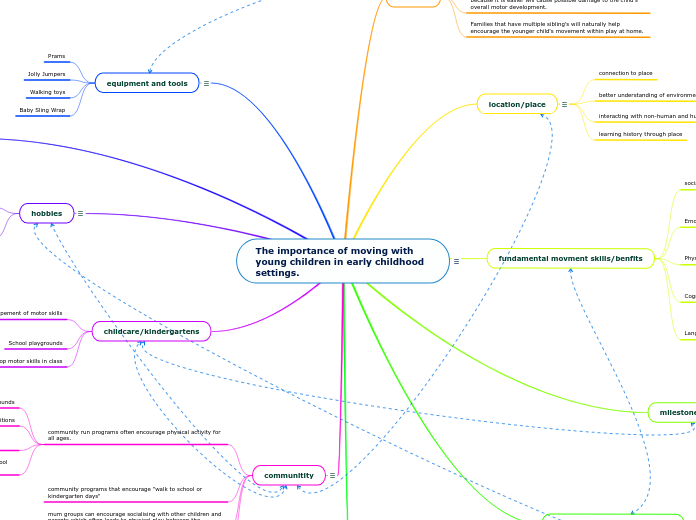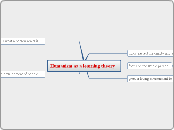The importance of moving with young children in early childhood settings.
Moving with young children is important in encouraging children to "form good habits for later years" as well as helping the development of not only the "physical, but also the social, language and intellectual skills" in which will assist them for life (Get Up and Grow Healthy Eating and Physical Activity for Early Childhood handbook, 2009).
communitity
The community can sometimes be a great recourse in developing skills within young children, but it can also cause conflict as not every public space or person within the community is child safe or appropriate. Attached to this bubble are some positive community based educational services for young children.
Active transport
"Active transport involves using physical activity, such as walking, pedalling a bike or using a scooter, to travel" this can be a great alternative rather than using prams and baby carriers in means of transport, this way your child is still learning motor skills even when on the go (Get Up and Grow Healthy Eating and Physical Activity for Early Childhood handbook, 2009).
mum groups can encourage socialising with other children and parents which often leads to physical play between the children.
community programs that encourage "walk to school or kindergarten days"
community run programs often encourage physical activity for all ages.
the council also run child programs for after school or school holidays which are heavily physical based.
advertisements on physical activity within tv shows and advertisements
community based competitions
parks and playgrounds
childcare/kindergartens
lesson planning to intentionally develop motor skills in class
School playgrounds
types of play that can assist in the devlopement of motor skills
structured play
"Structured play is planned play that may take place at set times, have certain rules or need special equipment" This type of play is more directed at certain skill developments and milestones to reach, for example problem solving activities or guided discovery sessions (Get Up and Grow Healthy Eating and Physical Activity for Early Childhood handbook, 2009).
unstructured play
"Unstructured play Unstructured play is creative and spontaneous play that gives children the freedom to move at their own pace and decide how they will play" This benefits children in all areas of skill development because they can imagine and create and play on their own terms. some example of this are outside play, loose parts play or even dancing to music (Get Up and Grow Healthy Eating and Physical Activity for Early Childhood handbook, 2009).
I am a strong believer in hobbies being a big part of development in movement skills, as I personally have experienced the benefits of it.
unique sports such as horse riding or ice skating and more, enable a high advancement in motor skills as some adults are not even capable of doing such tasks.
sports connects to many of the motor development skills required within young children
Questions on this topic
Why isn't the importance of movement in young children advertised more within society?
equipment and tools
Throughout the years there have been many different forms of equipment and tools put into place to help parents keep their children "safe" and close by. These items are heavily advertised to encourage the use of prams and other equipment. Studies have shown that a lot of the time parents overuse this equipment because it allows for a quicker and safer way to get daily tasks done without the worry of a child running off, these have been found to be overwhelmingly restrictive and delimits the child’s mobilities which effects the motor development in the early years of childhood (Horton, Christensen, Kraftl and Hadfield-Hill, 2013).
Baby Sling Wrap
Walking toys
Jolly Jumpers
Prams
things that encourage movement in children
outdoor play
games and music that require movment
There are many different songs and nursery rhymes that help to encourage dance and movement within early education, for example the "hokey pokey song" (Strickland, 2021).
chores or adult acitvities
Quite often children will want to do what the adults are doing, so to encourage movement you could let the child assist you with chores and household activities because even the smallest jobs can encourage movement.
my own expereince and veiws
My experience with developing motor skills as a child was a life changing situation, I grew up in a competitive horse-riding family so before I could even walk, I was taught to ride horses. By the age of four I was riding a horse completely by myself which included advanced motor skills that most children my age could not do. I feel as though most of my movement and physical development occurred on horses which allowed me to be an extremely fit and talented child regarding all sports and movement required activities. I am thankful for the encouragement in movement that I experienced as a child and would use these same techniques on my own future children.
family influence
School activities
hobbies
milestones
For each age group there is a milestone that is recommended to be reached. This can have positive and negative effects on a child. It can be used to know if the child is ahead or being in the skills they are developing, but can also be used for competitive reasons, and sometimes children will learn at different paces which could cause a parent to think their child is underdeveloped (Developmental milestones and the Early Years Learning Framework and the National Quality Standards).
Helps to figure out what the child will be learning next in order to plan activities and learning approaches ahead of time.
Capable of knowing if the child is advanced or even just on the right track, not necessarily to meet all requirements though as each child learns at their own pace.
fundamental movment skills/benfits
Language Skill
Throughout learning the language skill children become increasingly better at being effective communicators (Developmental milestones and the Early Years Learning Framework and the National Quality Standards).
Cognitive skill
This skill benefits children to form better understandings and meaning making within their play and education (Developmental milestones and the Early Years Learning Framework and the National Quality Standards).
Physical Skill
When the physical skills are built children are able to look after their own health and wellbeing which will support them for life (Developmental milestones and the Early Years Learning Framework and the National Quality Standards).
Emotional skill
This skill enables children to learn how to respond to diversity and make effective contributions to society (Developmental milestones and the Early Years Learning Framework and the National Quality Standards).
social skill
Social skills give children the required knowledge to understand their social identity within this world (Developmental milestones and the Early Years Learning Framework and the National Quality Standards).
location/place
Location and place play a huge role in the development of young children's motor skills. Depending on the place that the child is learning in will indicate whether they have the right opportunities to learn and play with movement or if they are overly protected within an indoor setting making it more difficult to develop those motor skills required in early education. A great example of this is the bush kinder, children have endless opportunities to play through movement in any way they desire, this has multiple outcomes of children gaining advanced motor skills, and confidence within every environment as well as becoming knowledgeable in the dangerous areas and situations that most children are protected from (SBS, 2016).
learning history through place
interacting with non-human and human entities
better understanding of environment
will grow up to a more respectful generation in regards to environment
connection to place
families
Families that have multiple sibling's will naturally help encourage the younger child's movement within play at home.
families who leave children on their technological devices because it is easier will cause possible damage to the child's overall motor development.
Knowledge on the importance of motor development in young children will determine how helpful they are at providing the right recourses for their child.
most parents who are educated on this will enrol their child in physical activities and hobbies or encourage movement at home.









